Cracked Teeth
It is one of the most common conditions we see patients for in our practice. Cracks in your teeth can develop due to one time injury (like biting on unpopped popcorn kernels) or over a period of time like grinding your teeth at night. You may experience a variety of symptoms ranging from sporadic pain when you chew your food to heightened sensitivity when the tooth is exposed to hot or cold temperatures. Your symptoms may come and go or you may not experience symptoms at all from cracked teeth. If a cracked tooth is not protected with a crown, cracks may progress deeper with time and eventually can expose the pulp tissue to bacteria from the oral cavity causing painful symptoms from either from pulpitis or dental abscess. If you experience these symptoms your dentist may refer you to an endodontist for further evaluation and treatment.
Endodontists use microscopes and 3D scans to properly diagnose location, type and extent of the crack and recommend appropriate treatment. With cracked teeth early diagnosis and treatment is essential to prevent further propagation of the crack and save your tooth. With proper treatment cracked teeth will function normally for many years to come.
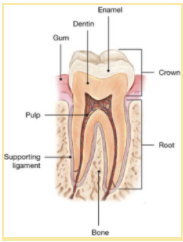
Knowing the basic anatomy of the tooth helps you understand why a cracked tooth hurts. Inside the tooth under the hard layers of enamel and dentin is the inner soft tissue called pulp. The pulp tissue contains the tooth's nerves, blood vessels and connective tissue. When the outer hard layers of the tooth are cracked biting and chewing can cause movement of the fractured pieces that causes irritation to the pulp which in turn causes pain. Initially a cracked tooth may cause pain with biting, hot and cold temperatures but eventually your tooth may start to hurt all the time. With some cracked teeth there may be no symptoms at all.
Cracked teeth are a very common phenomenon and this definition covers a wide range of conditions. The treatment we recommend for the cracked teeth depends on the location, type and the extent of the crack. Following are some examples of different types of cracks that we commonly see in our practice.
Chipped toothChipped tooth is one of the most common forms of traumatic dental injury. Most chipped teeth can be easily repaired by your dentist by restoring the missing portion of your tooth with a tooth colored bonded resin filling material. A root canal treatment is necessary if the pulp is exposed with the chipped tooth.
Craze Lines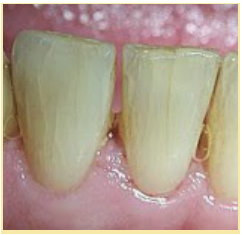
The most common and benign form of cracks are called craze lines and these are restricted to the hard outer enamel layer of the tooth. When teeth are subjected to repeated impact microcracks will start to develop in the structure of the enamel and over time these microcracks increase in size and start to join together to form visible Craze lines. They are extremely common in adult teeth and usually run vertically along the tooth surface. Someone may be concerned about the appearance of their teeth due to craze lines but they don’t cause any pain and require no treatment except for cosmetic reasons.
Fractured cusp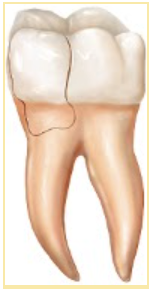
The chewing surface of the tooth is made up of two or more cusps. These cusps can become weak due to cavities and can break off under chewing pressure. The cusp can also be fractured under pressure if the tooth has large fillings. If a cusp of the tooth is fractured usually it is sensitive to air or cold fluids. Your dentist usually removes the fractured cusp and restores the tooth with a crown to protect it.
Cracked Tooth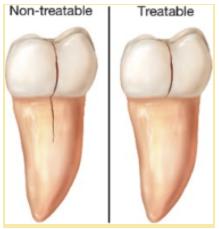
A cracked tooth is an incomplete fracture and the fracture line extends from the chewing surface of the tooth vertically towards the root. Fractured fragments usually don’t move. Bacterial contamination of the pulp tissue is like in this case. You may experience pain with biting (especially opening from the bite) and temperature. In some cases you may have constant pain. The tooth can be saved with a root canal treatment and crown if the crack is not extending on to the root surface. It is very important to treat a crack tooth as soon as possible to prevent further propagation of the crack onto the root surface. If the crack is extending on to the root surface then extraction of the tooth is usually required.
Split Tooth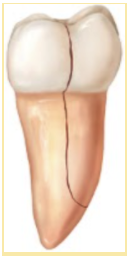
If the cracked tooth is not treated then it can turn into a split tooth with time. In this case the fractured fragments are moving and they can be easily separated. You can actually see a gap between the fractured fragments when slight wedging force is applied. There is no viable treatment for the split tooth and the tooth usually needs extraction.
Vertical root fracture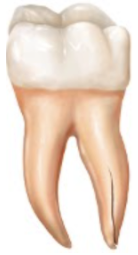
In case of vertical root fracture the crack usually starts on the root surface and extends towards the crown. You may experience mild to no symptoms with the teeth that have vertical root fractures and due to this reason there may be extensive damage to surrounding bone and gums before the patient notices it. Often you notice a pimple-like bump on the gum adjacent to the tooth or drainage through the gums.
- Don’t chew on ice, hard candy or unpopped popcorn kernels
- Don’t clench or grind your teeth and if you grind your teeth at night discuss with your dentist about getting a mouthguard to protect your teeth
- Wear a mouthguard while playing contact sports
- Maintain good oral hygiene to avoid developing cavities on your teeth. Cavities can weaken your teeth and make them prone to development of fractures.